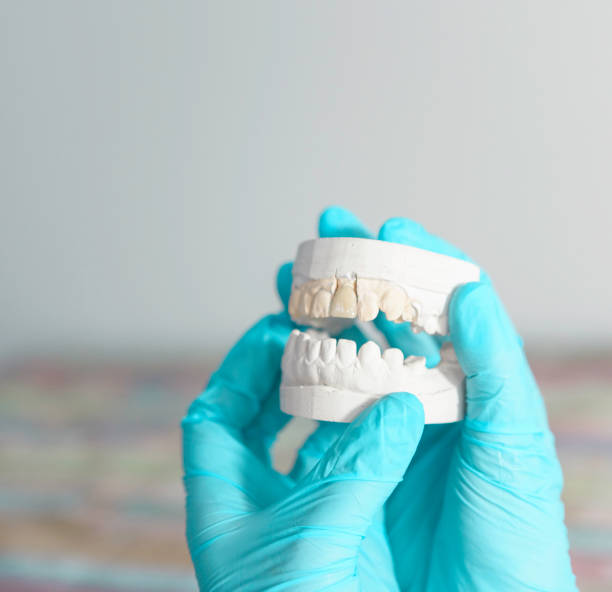
Dental crown and bridges in Abu Dhabi are common restorative dental treatments used to repair, strengthen, and replace damaged or missing teeth. Knowing when a dental crown or bridge is necessary involves understanding the indications for these procedures and considering various factors to determine the most appropriate treatment option. Let’s explore when a dental crown or bridge may be necessary and the considerations involved:
Indications for Dental Crowns
1. Protection of Weak or Decayed Teeth
- Severe Decay: Dental crowns are often recommended for teeth with extensive decay that cannot be adequately restored with a filling.
- Fractured Teeth: Teeth that are fractured or weakened due to trauma or extensive wear may require the protection and reinforcement provided by a dental crown.
- Large Fillings: Teeth with large fillings that compromise their structural integrity may benefit from the additional support of a dental crown.
2. Restoration of Broken or Damaged Teeth
- Cracked Teeth: Dental crowns can effectively restore cracked teeth, preventing further damage and preserving the tooth’s function and appearance.
- Chipped Teeth: Teeth that are chipped or broken can be restored with dental crowns, restoring their shape, strength, and aesthetics.
- Worn Down Teeth: Teeth that have become worn down due to bruxism (teeth grinding) or other factors can be restored with dental crowns to improve their function and appearance.
3. Cosmetic Enhancement
- Discolored Teeth: Dental crowns can conceal severe stains or discoloration that cannot be addressed with teeth whitening treatments, enhancing the appearance of the smile.
- Misshapen Teeth: Teeth that are misshapen or disproportionately sized can be reshaped and restored with dental crowns to achieve a more harmonious smile.
Indications for Dental Bridges
1. Replacement of Missing Teeth
- Single Tooth Replacement: Dental bridges are used to replace a single missing tooth by anchoring an artificial tooth (pontic) to adjacent natural teeth or dental implants.
- Multiple Tooth Replacement: Dental bridges can also be used to replace multiple adjacent missing teeth, restoring function and aesthetics to the smile.
2. Preservation of Oral Health
- Prevention of Shifting Teeth: Dental bridges help prevent adjacent teeth from shifting out of alignment into the space left by missing teeth, maintaining proper occlusion and bite function.
- Prevention of Bone Loss: By replacing missing teeth and restoring chewing function, dental bridges help preserve the underlying jawbone and prevent bone loss over time.
Considerations
1. Oral Health Status
- Overall Oral Health: The condition of the remaining teeth and supporting structures, such as gums and bone, will influence the decision to recommend a dental crown or bridge.
- Presence of Gum Disease: Active gum disease or periodontal issues may need to be addressed before proceeding with dental crown or bridge placement to ensure long-term success.
2. Patient Preferences and Goals
- Aesthetic Concerns: Patients’ aesthetic preferences and goals for their smile play a significant role in determining the most suitable treatment option.
- Budgetary Considerations: The cost of dental crowns and bridges may vary depending on factors such as materials used and the complexity of the procedure, so financial considerations may also influence the decision-making process.
3. Long-Term Prognosis
- Longevity: Dental crowns and bridges are durable restorations, but their longevity depends on factors such as oral hygiene practices, habits, and the materials used. Patients should be informed about the expected lifespan of their restorations and the need for regular maintenance.
Conclusion
Dental crowns and bridges are essential restorative treatments used to repair, strengthen, and replace damaged or missing teeth. Indications for these procedures include protecting weak or decayed teeth, restoring broken or damaged teeth, replacing missing teeth, and enhancing the appearance of the smile. Considerations such as oral health status, patient preferences, budgetary concerns, and long-term prognosis are crucial in determining the most appropriate treatment option for each individual patient.
FAQs
-
Are dental crowns and bridges painful to get? Dental crown and bridge placement is typically a minimally invasive procedure that is well-tolerated by most patients. Local anesthesia is used to numb the area, ensuring a comfortable experience.
-
How long do dental crowns and bridges last? With proper care and maintenance, dental crowns and bridges can last for many years, providing a long-term solution for damaged or missing teeth.
-
Can dental crowns and bridges be whitened? Unlike natural teeth, dental crowns and bridges cannot be whitened with traditional whitening treatments. However, professional cleaning can help maintain their appearance.
-
Do dental crowns and bridges require special care? Dental crowns and bridges require regular brushing, flossing, and dental check-ups, just like natural teeth. Avoiding hard foods and habits like teeth grinding can help prolong their lifespan.
-
Are dental crowns and bridges covered by insurance? Many dental insurance plans cover the cost of dental crowns and bridges, especially when they are deemed medically necessary for restorative purposes.


